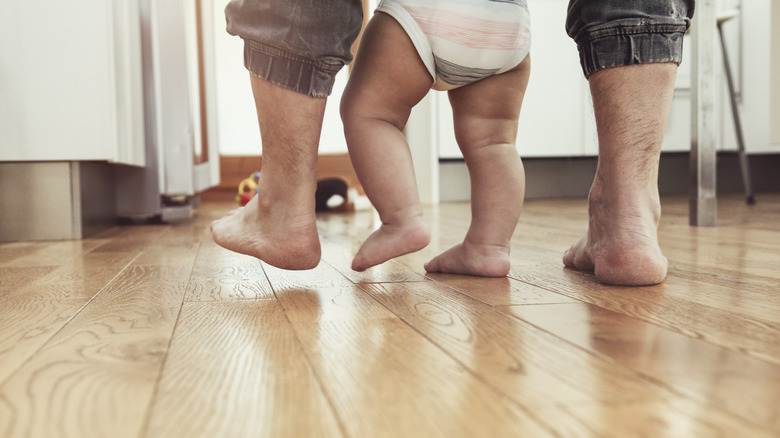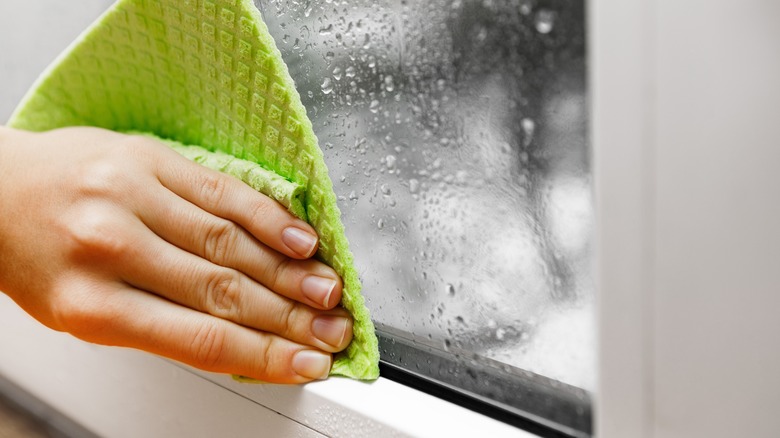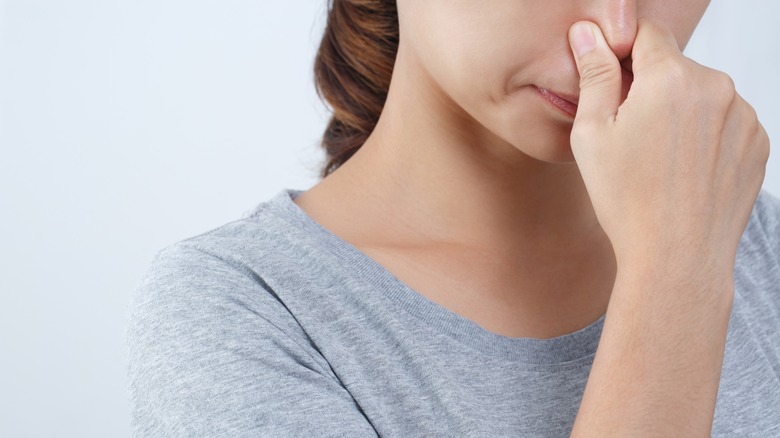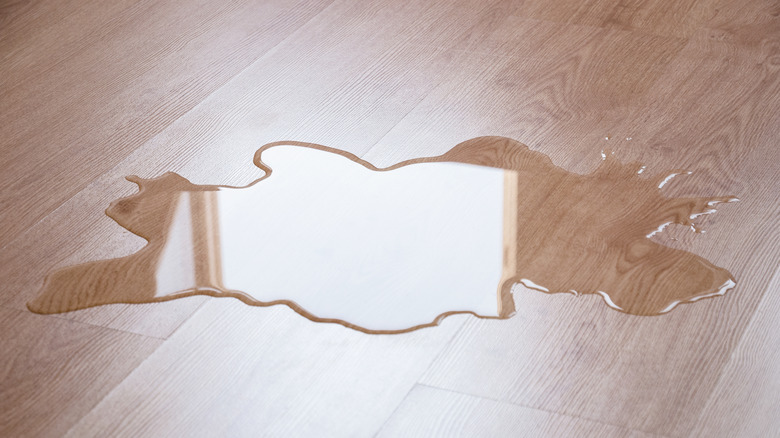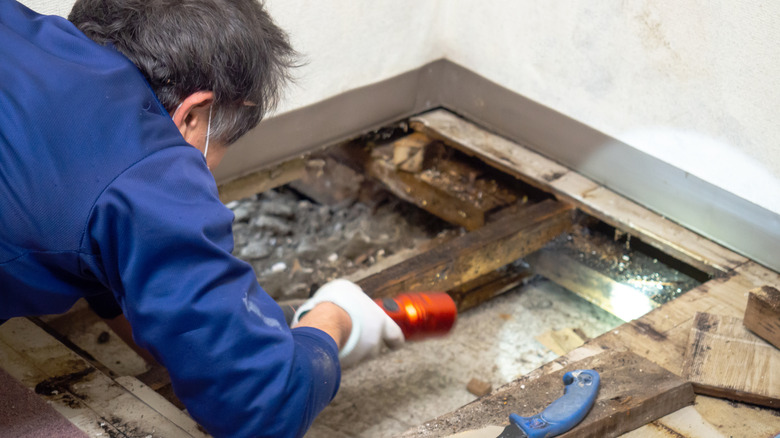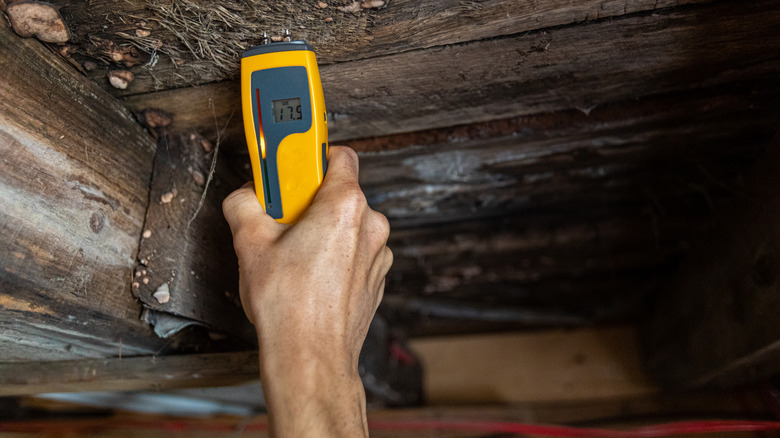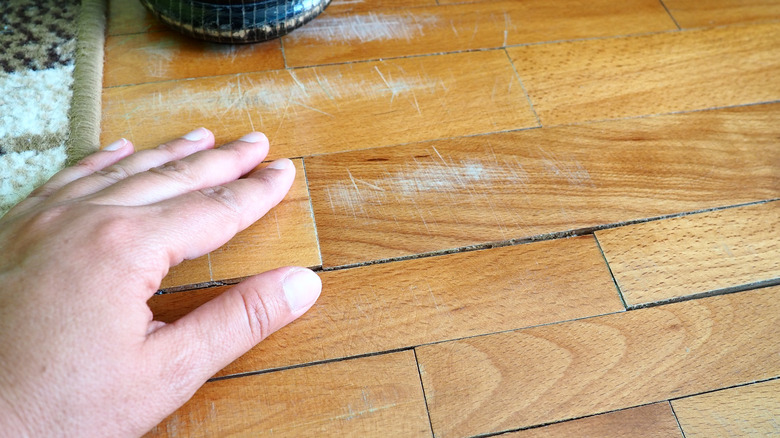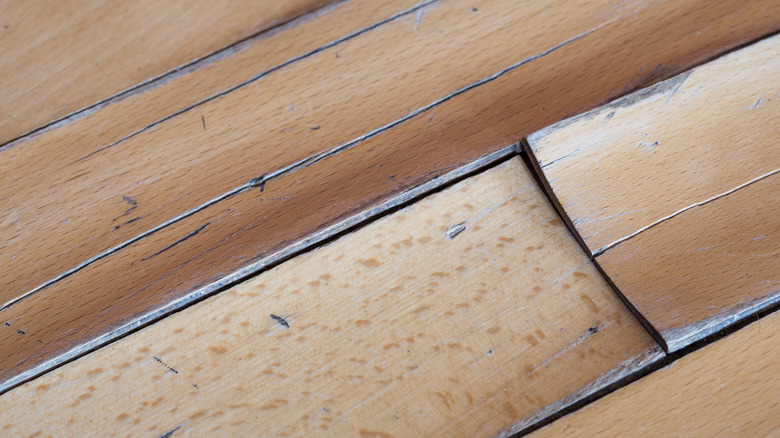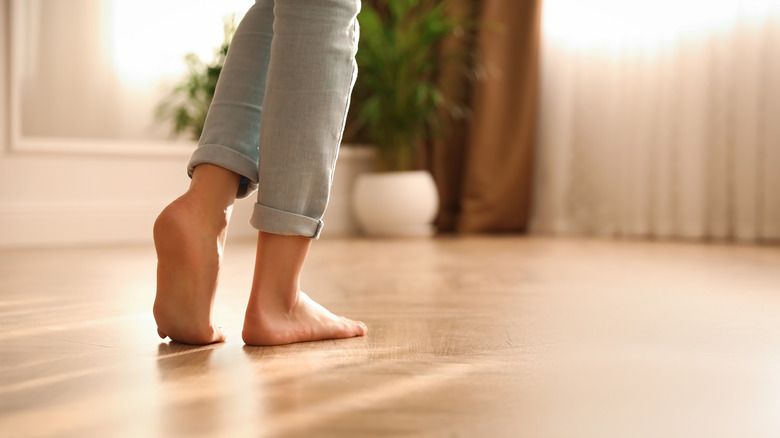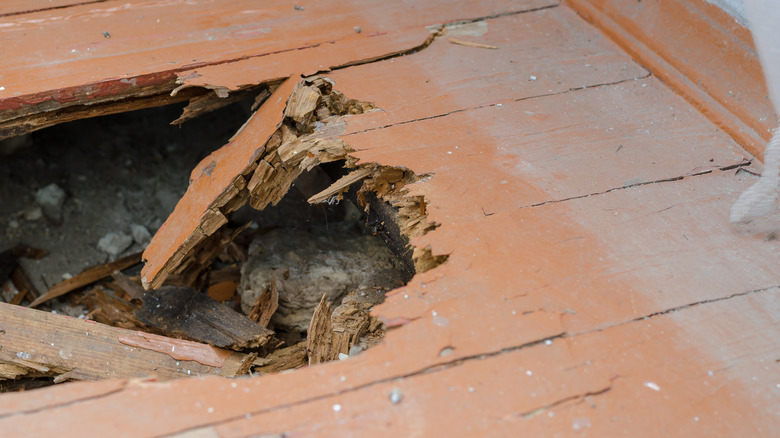10 Sneaky Signs There May Be Mold Lurking Under Your Hardwood Floors
You've invested in hardwood floors, or maybe you purchased a home with existing wood floors in seemingly great shape. But have you ever thought about what could lurk beneath those polished surfaces? One culprit is mold. While hardwood is less susceptible to mold compared to other types of flooring, like carpet, it's not completely immune. So, there are some signs you can watch for to detect its hidden presence.
A musty odor and standing water are some red flags you shouldn't dismiss as features of an aging home. Since mold thrives in damp, dark (and often less-visited) areas of the home, it can be easy to overlook. And while a noticeable smell is one obvious indicator, there are subtler ways mold can announce its unwelcome presence.
The good news is that mold, while persistent, can be managed and often eliminated if you catch it early enough. It's all about being attentive and knowing what to look for. Catching these sneaky signs of mold early can save you from health problems and costly repairs later on.
You notice increased humidity
You might not immediately associate higher humidity levels with mold lurking beneath your hardwood floors, but there's a connection worth your attention. Maybe you notice your home feels more humid than usual. Or, if you've spotted other signs of increased humidity, like fogged windows, it might be time to check your floors.
When humidity levels rise, the air holds more water vapor and your floor's porous surface can absorb this extra moisture. Hardwood floors are particularly vulnerable because wood is porous and hygroscopic, so it naturally absorbs moisture from the air. When moisture enters your floors, it can foster a favorable environment for the growth of mold that needs a damp environment to grow. Elevated humidity levels can be like a dinner bell for dormant mold spores, signaling them to start their lifecycle.
So, how would you approach this? Invest in a trustworthy hygrometer to keep an eye on the humidity levels in your house. Try to maintain an indoor humidity level between 30% and 60%. If the moisture levels are constantly in the higher range, consider using a dehumidifier in humid spaces. Exhaust fans can also help regulate moisture and enhance ventilation in high-humidity rooms like the kitchen and bathroom.
Smelling a musty odor
If your hardwood floors smell like socks or damp paper, that's a red flag. That musty odor is often the first warning of mold growth. The answer to this smell lies in the science behind microbial volatile organic compounds (mVOCs). Let's break this down. Mold consists of tiny organisms that thrive on moisture and organic matter. As it grows, it produces mVOCs, which are gases that are emitted into the air. These compounds are what create that telltale, musty smell. While not all mVOCs are harmful, some can be irritants, especially for people with allergies, asthma, or sensitive noses.
The intensity of the smell may vary depending on factors like the airflow and even the humidity level in your home. You have a good reason to investigate further if you notice a consistent musty odor, especially around your hardwood floors. First, try to locate the source. Even if the entire floor smells, it might be strongest near the mold growth, so follow your nose. Once you pinpoint the area, it's wise to consult professionals for testing and remediation.
You see standing water
Not just a slip hazard, standing water sets the perfect stage for mold to grow. You might wonder, how did this even happen? Well, several culprits can be at play here, including plumbing leaks and clogged drains. Even poorly sealed windows can cause rainwater to pool on your floors. Don't overlook accidental spills or even the water people track in on their shoes during rainy days. And let's not forget, high humidity levels can sometimes cause floor condensation, especially in basements or lower home levels. Over the years, your hardwood might develop gaps, creating sneaky pockets where water can collect.
First, hunt down the source of that moisture. If it's a leak, you might need to call in a plumbing pro to get that fixed. Once you've stopped the water issue, you'll want to check under your flooring. Chances are, if standing water has been able to pool for some time, it's made its way downward, creating a prime home for mold.
Discoloration in various shades
You've put effort into choosing the perfect shade of hardwood to compliment your home's aesthetics. The last thing you need is discoloration caused by mold. And while you might think mold is just a plain, ugly green, mold can actually manifest in a spectrum of hues, including black, yellow, and even white. Black mold is often considered the most dangerous due to its potential toxicity, but don't let that lull you into dismissing other colors. Each color has its own characteristics and potential risks.
So why does mold even cause discoloration? Let's delve into the science. Mold spores attach to the wood and feed on its organic compounds. As they grow and multiply, they produce pigments that cause the wood to stain. These pigments can penetrate the wood fibers deeply, making the stains difficult to remove.
If you notice discoloration, your first task is to examine the area carefully, perhaps even using a magnifying glass. You're looking for tiny, fuzzy spots of mold growth. If it's a small, surface-level problem, you can clean it yourself using a mold-removal solution. However, it could also mean that deeper layers of the flooring are also harboring mold. So, a professional remediation service is often the best course of action for widespread discoloration.
Powdery and spongy texture
Powdery or spongy textures on your hardwood floors can be alarming signals that mold has taken up residence. What appears to be a minor textural change is actually a sign of a more serious problem. When mold sets in, it breaks down the material it's growing on, in this case, your hardwood floors. This is when the surface can start to feel spongy underfoot. On the other hand, a powdery texture is often the result of mold spores multiplying and forming a colony. These spores generate the powdery substance you see, which is essentially a mass of tiny mold spores waiting to be dispersed.
So why is it a big deal? Well, a spongy floor is a weakened floor, and that means structural instability. A powdery surface means active mold growth and potential health risks, especially for those with respiratory issues. You're not just dealing with an aesthetic issue; you're grappling with something that can affect your home's safety and your family's health. Call the professionals if the extensive powdery or spongy area or the wood seems severely weakened. You might be dealing with a mold issue that has permeated beyond the surface, requiring more aggressive treatment.
Warped and buckling floorboards
Buckling or uneven floors occur when the floorboards lift from the subfloor beneath them. If your once-flawless hardwood floors are now warping or buckling, once again, it could be due to the wood's reaction to moisture. As mentioned earlier, wood is a porous material. It swells when it absorbs moisture from the air or a water source. Conversely, when it loses moisture, it shrinks. This constant expansion and contraction can cause the wood to distort, leading to warping. Furthermore, when there's excessive moisture, there's a good chance that mold can grow beneath the boards.
So, what's your game plan? If the warping or buckling is extensive, or if you suspect mold growth beneath the boards, once again, it's time to consult the pros. They can assess the condition, recommend the best course of action, and handle removing and replacing damaged boards. They can also inspect for mold and carry out remediation if necessary. Then, to fortify your floors, using moisture barriers or sealants can help protect it from future moisture-related problems.
Keep an eye out for peeling floors
You might think the flaking or peeling of your hardwood floors is simply a cosmetic concern, perhaps a sign that it's time to refinish the surface. While that could be true in some cases, it is another sign that the surface layers of your wood floors are starting to deteriorate, similar to the warping or buckling. Peeling is typically a surface-level phenomenon. The wood's protective finish or the sealant applied to keep it pristine starts breaking down. However, the peeling is also a warning to act before mold becomes a larger issue. Even if moisture isn't the direct cause of the flaking, a compromised surface could mean that the wood is more vulnerable to mold, as it creates points of entry for moisture and spores. Therefore, while flaking might appear less alarming than, say, a spongy texture, it's an early sign that shouldn't be ignored.
Addressing this issue is vital to preventing future accidents like scrapes and cuts. After checking for mold, you'll want to refinish the floors and choose a water-resistant sealer to minimize future risks. This type not only protects against moisture but also contains compounds that deter mold growth. For the best results, you may want to consult a flooring specialist who can guide you through the selection and application process.
Listen for creaking floorboards
While creaking floorboards are often chalked up to the charm of an older house or changing weather conditions, they can also be an overlooked sign of mold-related issues. As mold affects the structural integrity of your hardwood floors, these boards may have less effective connection points to the subfloor or neighboring boards, leading to minute shifts under pressure — hence, the creaking noise. The hidden culprit might not just be age or fluctuating humidity levels but an insidious mold problem affecting the floor's durability and causing it to make unsettling sounds.
If you want to dive deeper into what's going on with those creaky floorboards, as with the earlier methods, start by pinpointing the problematic boards. It might help to remove any furniture and rugs from the area to inspect the floor more closely. Check for any visual signs of mold or moisture underneath the boards. If it's clear, you can reinforce your entire floor with additional screws or fasteners to prevent future creaking. You can also lubricate your floorboards to minimize friction.
Insect infestations can be a bad sign
The sight of bugs in your home sometimes serves as a warning signal for underlying issues. When you spot an increase in insect activity, your hardwood floors could be harboring hidden mold. For example, mold beetles are known for their attraction to moldy and damp environments. They're usually less than three millimeters long and their larvae thrive in mold. When these insects appear, it's usually a sign of an established problem that needs immediate attention. These beetles feed on molds and other fungi, giving them the nutrients they need to survive and reproduce. In turn, their presence in your home indicates a stable, abundant source of mold that could be detrimental to the condition of your hardwood floors.
Like the presence of increased humidity, as mentioned earlier, mold beetles can indicate conditions conducive to mold growth. They are not just invaders but also signs of an environment that's going awry. If you focus only on getting rid of the beetles, you're treating the symptom, not the underlying cause. So, eliminating the mold becomes a pivotal step in solving your beetle problem and preserving your floors.
You have new or dramatically worse allergy symptoms
If you find yourself sneezing, coughing, or experiencing irritated eyes more often than usual, it might be more than just seasonal allergies. These symptoms could be your body's way of alerting you to a problem with mold lurking under your hardwood floors. Mold produces allergens, irritants, and even mycotoxins — compounds capable of causing health problems. The tiny spores can find their way into your respiratory system. The result? Allergic reactions that can range from mild irritations to more severe respiratory issues.
As mentioned earlier, factors like increased humidity can lead to mold growth, and this subsequently increases indoor allergens. Therefore, it's crucial to not dismiss any new or suddenly worsening allergy symptoms too quickly, especially if you've noticed other signs like higher indoor humidity or insect activity. To address the issue, make sure to have a remediation pro ensure that your home and flooring are as mold-free as possible.
